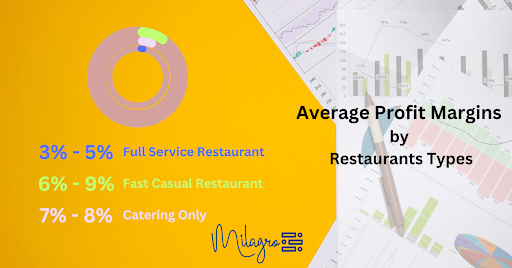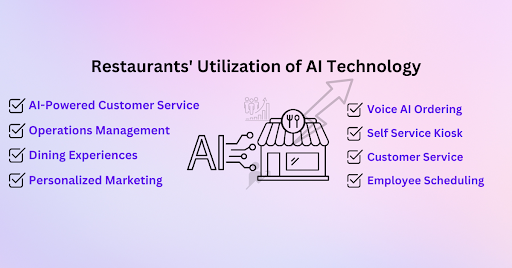Those familiar with the restaurant industry are aware that profit margins in restaurants are usually thin.
However, the belief that restaurants must operate on tight budgets is a misconception. Although it requires hard work, dedication, and careful planning, with the right skills and strategies, you can enhance your restaurant’s profit margin and convert your efforts into financial success.
How do you determine your restaurant’s profit margin? What is the typical profit margin for a restaurant, and why are they often low? And, most importantly, what are some simple ways restaurants can reduce expenses, increase revenue, and enhance their financial performance? Continue reading to find out more.
What Does Restaurant Profit Margin Mean?
Your restaurant’s profit margin is the profit you make annually, expressed as a percentage of your yearly sales.
Profit is the amount left after deducting operating expenses, food expenses, and wages. It can come from sources beyond food sales, such as catering, venue rentals, merchandise sales, franchising, and packaged goods.
Likewise, a restaurant may have various expenses that must be subtracted from its total revenue before determining its profit margin: inventory, payroll, rent, utilities, marketing expenses, credit card processing fees, maintenance and repairs, and technology used in restaurant operations.
To calculate your profit margin, you’ll need a few other figures.
What Is the Average Restaurant Profit Margin?
You might see a taco spot with an 11% net profit margin and wish yours was as high. This figure is slightly above the average restaurant profit margin, which has been decreasing over time.
Consider Philadelphia, a city known for its culinary scene. Two decades ago, restaurants in Philly had profit margins averaging 15-20%. Today, that average has dropped to 4-7%, aligning with the national average for restaurant profit margins.

Of course, profit margins can vary significantly based on the restaurant type, location, and other factors. Average profit margins for common restaurant types are typically around:
- 3-5% for full-service restaurants
- 6-9% for fast-casual restaurants
- 7-8% for catering-only businesses
In this modern digital age of restaurants, customers expect more from each dining experience. Understanding how technology and restaurants can collaborate will give you a competitive edge. By working smarter, increasing revenue, and turning every guest into a regular, you can enhance your restaurant’s success.
Here are five ways restaurant technology can help your business and enhance your guest experience.
1. Improve your restaurant’s website
Research shows that over 80% of guests check out a restaurant before dining, and 81% make decisions based on the restaurant’s website. Your website is the first impression guests have of your business, so it’s crucial to make it better.
How to improve your restaurant’s website? Regularly update the menu to show transparency and keep your operating hours current. Ensure you have a user-friendly reservation system that aligns with your restaurant’s branding.
Remember, most people use their phones to go online. Make sure your website is mobile-friendly and easily accessible on smartphones and tablets.
2. Enhance your payment system
Are you using a payment platform that accepts online payments from anywhere in the world?
Your customers are online and expect a convenient payment process. Having the right payment technology allows you to sell tickets, host pre-paid events, request deposits, and sell gift cards online, opening up new revenue streams and increasing profit margins.
3. Obtain a comprehensive business overview
Invest in a restaurant management system that automatically gathers data. Understanding everything from staff performance to top-selling dishes provides a complete picture of your business performance.
This data can boost your revenue, improve guest experiences, and encourage repeat visits.
Older platforms may offer these insights separately, but newer restaurant technology combines these systems into a single, easy-to-use platform.
4. Update social media to increase online presence
Restaurant technology goes beyond POS and payments; it includes your online presence.
The most common way people search for restaurants is through smartphones. Ensure you have a shareable reservation link that works on all social media platforms, making it easy for potential customers to find you.
Identify which social media channels (Facebook, Instagram, Twitter, TikTok) are popular with your guests and focus on those. Engage with your online audience by responding to comments, liking photos, and addressing both positive and negative reviews. Utilize social media for promoting events and online registrations.
Email marketing is also an effective method to engage with your audience. Send emails announcing new menu items, specials, or other information to keep your guests informed.
5. Utilize guest data
Guest data is essential for restaurant success and increasing profit margins. It’s the foundation for building loyalty and ensuring guests return and recommend your restaurant.
Knowing guests’ names is a good start, but it’s not enough. They expect personalized experiences and to feel at home. Collect their data to achieve this.
Choose a platform that allows you to create guest profiles, track visits, average spending, favorite items, food allergies, and more. Platforms like Milagro’s CDP Management can help you collect and analyze guest data to enhance experiences and boost revenue.
Decrease Restaurant’s Costs
To increase your restaurant’s profit margin, consider lowering costs through the following methods:
1. Reduce your cost of goods sold (COGS):
– Explore different vendors for better deals.
– Purchase ingredients in bulk to cut costs.
– Focus on menu items that are more cost-effective to prepare.
2. Lower labor costs:
– Optimize staffing based on traffic trends, ensuring the right number of staff during busy and slow periods.
3. Utilize Artificial Intelligence (AI):
– AI technology can enhance efficiency at a low cost, such as automating phone responses and generating marketing content.
4. Minimize waste:
– Food waste in restaurants amounts to significant costs annually. Improve inventory management to reduce waste.
5. Address employee turnover:
– High turnover rates can be costly. Offer competitive wages, and benefits, and create a positive work environment to retain staff members and reduce recruitment expenses.

Invest in Technology – Even When Profits Are Down
Boosting restaurant profit margins can involve investing in technology, even during periods of reduced profits.
Utilize restaurant technology tools like Milagro, an all-in-one digital platform, which can help increase revenue by:
– Establishing and managing a website
– Creating an interactive online menu
– Providing direct online ordering
– Automating digital marketing tasks
Additionally, Milagro aids in cost reduction by offering all these features in a single platform with a consistent, affordable monthly fee. Accessing essential technology tools through Milagro simplifies and makes it cost-effective for restaurants to thrive in the digital era.
4 Ways Technology Increases A Restaurant’s Brand Value
Implementing technology in your restaurant should focus on solutions that enhance operations without burdening your team. Opting for reliable tech tools can address operational challenges, distinguishing businesses from those using outdated methods. Embracing technological innovation is crucial in the competitive hospitality industry, elevating brand value and ensuring scalability. This approach highlights four key ways technology boosts your restaurant’s brand value, emphasizing the importance of staying ahead in the digital landscape.
Let’s explore how technology can enhance the value of your restaurant brand in four different ways.
Technology = Automation
When automating restaurant processes, reduces manual work for staff, allowing them to concentrate on customer interactions for an exceptional experience. Front-of-house technology solutions enable staff to focus on their tasks without being distracted by manual processes, enhancing brand rapport through meaningful tableside interactions.
Technology = New Markets
Implementing technology to streamline management processes enables brands to expand into new markets through physical locations or meet the growing off-premise dining trend. Back-of-house technology solutions offer efficiency during expansion, such as recipe viewer tools that ensure consistent preparation across multiple kitchens. Adapting to online ordering and delivery demands is crucial for restaurants to stay competitive, requiring seamless communication between front-of-house and back-of-house technologies to manage operational challenges effectively.
Technology = Consistent Feedback
Restaurants benefit greatly from obtaining and promptly acting on quality feedback to enhance their brand reputation. By leveraging mobile apps and guest surveys, restaurants can engage with customers consistently and receive immediate feedback, enabling them to address issues swiftly and prevent negative reviews from becoming public. Embracing guest survey technologies allows restaurants of all types to gather valuable insights and make operational improvements promptly, ensuring a positive dining experience for customers across different dining formats and environments.
Technology = Quicker Payments
Finally, in the business world, technology has significantly influenced restaurants, particularly in the realm of payments. While faster payments benefit owners, they are equally appreciated by consumers who dislike waiting. A restaurant must accommodate customers’ time constraints to maintain the brand’s value. Utilizing technology to enable convenient tableside payments not only enhances customer experience but also boosts table turnover, ultimately contributing to increased revenue at the end of each month.
Next Steps
Before engaging with a technology partner, take the time to identify your operational challenges. Outline your short-term and long-term goals, whether it involves expanding to multiple locations, introducing takeout options, or gathering customer feedback for business improvements. Having a clear list of objectives will better prepare you to connect with technology vendors who can provide tailored solutions. Look for technology that seamlessly integrates front-of-house and back-of-house operations, remains relevant over time, and minimizes manual processes. By selecting the right technology, you can enhance your restaurant brand and optimize operations effectively.





